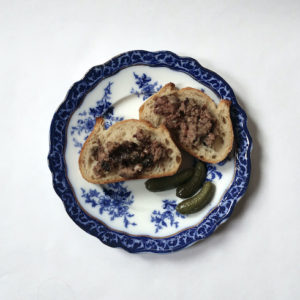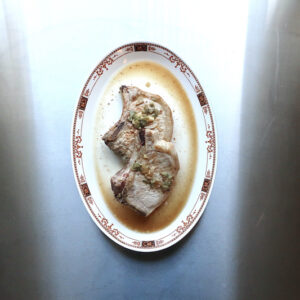Winter Pate
You’ve made meat loaf, right? You’ve eaten cold meat loaf, yes? Then you’re halfway to being a an ass-kicking, name-taking charcutier. “Ooooh…pate, I don’t know.” Please. Campagne means “country” in French–which means even your country-ass can make it.
Anthony Bourdain (who else?) Les Halles Cookbook
Today’s recipe came about after a recent experience with commerical pate. The label said all the right things: humanely treated animals fed nice green things, the whole operation running on vegetable oil, locally sourced, you know the drill. A generous slice of this stuff cost slightly less than a three course meal, and while it wasn’t bad, neither was it especially good. I thought, perhaps egotistically, that I could do better. Below are the results.
—
A few words before we begin cooking….

Traditional pate recipes rely on generous amounts of fat. Never once have I seen a pate recipe calling for margarine or any other butter substitute. If you have a problem with animal fats, this isn’t the recipe for you.

Pates never win photo contests. They are not instagram friendly. If you are hoping to clinch the next InstaPhotoContest, search your summer photo pictures for an eggplant dish.

Not eggplant, but taken last July. (July 2023).
Pates are a capacious subject far exceeding the reach of my measly blog. If your interest is piqued, I refer you to the late, great Jane Grigson, whose Charcuterie and French Pork Cookery, published in 1967, remains one of the seminal texts on the topic.

—
In an ideal world–certainly not the one we inhabit–your raw pate ingredients will have an opportunity to marinate in the fridge overnight. At the moment (I write on December 18th) this is a laughable suggestion. But keep it in mind for future pate adventures. This is a recipe that you can make all winter long.

A word about seasonings: if you’re unsure about your mixture, form a small patty as a taster. This avoids making an entire under or over-salted pate.

Once your pate comes out of the oven, you must pour off the accumulated cooking juices. If you don’t, the pate’s keeping time will be seriously compromised. Tip the juices into a heatproof cup or dish. They make a wonderful addition to any dish needing a boost. I poured mine into that evening’s soup. These cooking juices would also be delicious in rice, stew, chicken, or polenta. They also freeze well.

A pate’s keeping time may be extended up to ten days by a pouring a layer of clarified butter, duck, or pork fat over the top, then covering it with foil and refrigerating it. Once the seal is broken, consume the pate within five days or so.

Pate is a great appetizer, provided people refrain from eating too much of it. It als makes a nice light meal with salad, bread, and cornichons. This is also a good time to bring out the pickled grapes, posted on 10-25-23.

Winter Pate
Yield: one 9 inch/23 cm pate
Prep time: about 30 min active time/about 90 min baking time
This pate is best made using a food processor, but a sharp knife will work, too.
4 ounces/115 grams chicken livers
1 shallot, peeled and roughly chopped
1-2 garlic cloves, crushed
2 tbsp fresh parsley, chopped
1 pound/454 g ground pork, not lean
4 ounces/115 g pancetta, cubed
3 tbsp cranberries
2 tbsp brandy, Madeira, Cognac or port
2 tsp fine sea salt
2 tsp pepper
Preheat oven to 325F/160C
Have an 8in/22cm or 9in/23cm loaf pan ready.
You will also need a large mixing bowl to blend the ingredients.
Rinse the livers in a colander set in the sink. Carefully remove any greenish bits, as they are bile sacs and will make the pate bitter.
Pat livers dry and put them in processor (or chop finely). Blend into mush. They’ll look horrible. Disregard this. Tip into bowl.
You don’t have to wash the processor unless you find it unbearable. Add the shallot, garlic, and parsley. Just give them a rough chop. Don’t emulsify them. Add to the chicken livers.
Wash the processor.
Now add the remaining ingredients to the bowl. Blend with your clean hands and pat in the loaf pan. Tap pan on counter a few times to ensure there are no air bubbles.
Place the loaf pan in a larger baking pan. Carefully fill the baking pan with enough water to come halfway up the sides of the loaf pan. Place this setup in the oven.
Bake for 90 minutes, or until a thermometer placed in the middle of the pate reads 160F/71C. Lacking a thermometer, look for the loaf to exude clear to yellowish juices and be pulling away from the sides of the pan. It should not be pinkish, save the cranberries. Pate should look and smell done.
Remove pate from oven and pour cooking juices off into a heatproof measuring cup. As noted in the post, these juices are delicous. Don’t throw them out. Use in rice, soups, grains, poultry, or meat dishes. The cooking juices may be frozen. It is inadvisable to freeze the pate.
Pate may be sealed with clarified butter, duck, or pork fat for extended keeping. Once seal is broken, consume within 5 days.
If you do not seal the pate, allow it to rest, covered and refrigerated, up to three days. Eat within five days with pickles, bread, crackers, and/or salad.
Notes:
There are as many variations for pate making as there are cookbooks. You can substitute dried prunes plumped in liquor, currants, raisins, or any other dried fruit you like. You may also omit the fruit entirely.
Some people like chopped pistachio in their pates. I am not one of them.
Omit or use other liquor in the pate. Or use a dry white wine.
Substitute different meats and/or fats. If you do not eat pork, make the pate with chicken or duck. If you have come into an inheritance, Jacques Pepin and Julia Child have wonderful recipes for pate using pheasant and foie gras. Richard Olney’s Simple French Food is another excellent reference on pate and terrine making.
A final note concerning diacritical marks. That is accents, or lack thereof. WordPress has made changes to the back end of this software blocking my access to spellcheck and the tools grid containing accent marks. I suspect upgrading–i.e. paying more money–would restore access. This is not a criticism of WordPress. Just an explanation. For now, know I’m aware of the missing marks and apologize for them.
Have a safe and happy holiday season, and thank you for reading.





